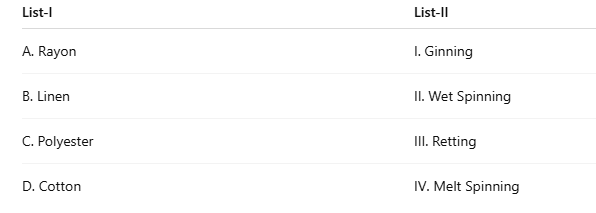Correct option is D
Rayon (A):
Wet Spinning (II)
·
Rayon is indeed produced using the
wet spinning method. This involves dissolving the cellulose into a chemical solvent, and then the solution is extruded through a spinneret to form fibers. This is the most common method for producing rayon, making
wet spinning (II) the correct process for
Rayon (A).
Linen (B):
Retting (III)
·
Linen is made from the fibers of the
flax plant, and
retting is the key process used to extract these fibers. Retting involves soaking the flax stalks in water to decompose the pectin and other materials that bind the fibers to the stalk. After retting, the fibers are separated and processed into linen. Hence,
retting (III) is the correct process for
Linen (B).
Polyester (C):
Melt Spinning (IV)
·
Polyester is a
synthetic fiber produced using the
melt spinning method. In this process, polyester chips are melted and then extruded through spinnerets to form fibers. As
polyester is a man-made fiber, it follows
melt spinning (IV), making it the appropriate process for
Polyester (C).
Cotton (D):
Ginning (I)
·
Cotton fibers are separated from the cotton seeds using the process of
ginning. This is the process where cotton bolls are mechanically separated, and the seeds are removed, leaving the fibers ready for further processing. Therefore,
ginning (I) is the correct process for
Cotton (D).
Information Booster:
·
Wet spinning is used for
rayon as it requires a chemical solution to form fibers.
·
Retting is specific to
linen, which involves soaking flax fibers to loosen them.
·
Melt spinning is the most common process for
polyester, as it involves melting and extruding the material.
·
Ginning is used for
cotton, separating the fibers from the seeds for further processing.






 English
English 50 Questions
50 Questions 60 Mins
60 Mins


